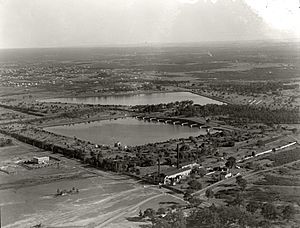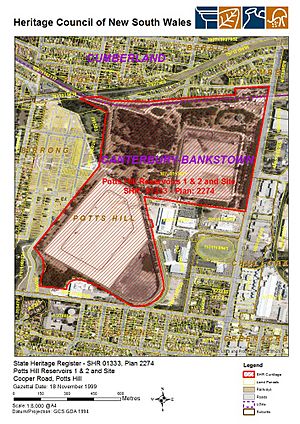Potts Hill Reservoirs 1 and 2 facts for kids
Quick facts for kids Potts Hill Reservoirs 1 and 2 |
|
|---|---|

Potts Hill Reservoirs, 1937
|
|
| Location | Cooper Road, Potts Hill, City of Canterbury-Bankstown, New South Wales, Australia |
| Built | 1880– |
| Architect | Board of Water Supply and Sewerage & Sydney Water |
| Owner | Sydney Water |
| Official name: Potts Hill Reservoirs 1 & 2 and Site | |
| Type | state heritage (built) |
| Designated | 18 November 1999 |
| Reference no. | 1333 |
| Type | Water Supply Reservoir/ Dam |
| Category | Utilities - Water |
| Lua error in Module:Location_map at line 420: attempt to index field 'wikibase' (a nil value). | |
The Potts Hill Reservoirs 1 and 2 are important heritage-listed reservoirs located in Potts Hill, New South Wales, Australia. These large water storage areas were designed by the Board of Water Supply and Sewerage and Sydney Water. Construction began in 1880.
The reservoirs are owned by Sydney Water, which is a state government organization. They were added to the New South Wales State Heritage Register on 18 November 1999. This means they are recognized as important historical sites.
Contents
History of Sydney's Water Supply
How Sydney Gets Its Water
For a long time, Sydney needed a reliable way to get fresh water. Before the Upper Nepean Scheme, the city used water from places like the Tank Stream and Busby's Bore. As Sydney grew, these sources were not enough.
In 1867, a special group was formed to find a better water supply for Sydney. By 1869, they suggested building the Upper Nepean Scheme. This big project would collect water from the Nepean River.
Water would flow by gravity through tunnels, canals, and aqueducts. These channels are known as the Upper Canal. The goal was to bring water to a large reservoir at Prospect.
Building Prospect Reservoir
The Prospect Reservoir was a key part of the Upper Nepean Scheme. It was built by the Public Works Department of NSW. Construction took place during the 1880s and finished in 1888.
A man named Edward Orpen Moriarty was very important to this project. He was the Engineer in Chief for Harbours and Rivers. He helped design and build the entire Upper Nepean Scheme.
The Potts Hill Reservoirs' Role
The Potts Hill site has two main reservoirs. The first, Potts Hill Reservoir No. 1, was built between 1887 and 1889. It was a vital part of the original Upper Nepean Scheme, which started operating in 1888.
Potts Hill Reservoir No. 2 was built later, in 1923. It is almost twice as big as the first one. It was added to help meet Sydney's growing water needs.
Originally, Prospect was the main storage reservoir for the whole system. Potts Hill No. 1 was a "service reservoir." This meant it helped manage the daily changes in how much water people needed.
Today, both Potts Hill reservoirs are still very important. They act as key service reservoirs for a large part of Sydney's southwestern area. Prospect Reservoir now also serves as a service reservoir.
What the Reservoirs Look Like
The Potts Hill Reservoir site is located on a high point near Regents Park and Bankstown. It is surrounded by Rookwood Road, Brunker Road, Cooper Road, and the Sydney Water Supply Pipelines.
Reservoir No. 1: An Older Design
Reservoir No. 1 is shaped like a rectangle. It has earthen banks with a special clay core to prevent leaks. The floor is made of concrete.
The inner sides of the banks are lined with sandstone blocks. You can see places where these linings have been repaired over time. This was done with both sandstone and concrete.
Reservoir No. 2: A Modern Shape
Reservoir No. 2 has a more triangular shape. Its walls and floor are made from large amounts of concrete. This shows a different building style compared to Reservoir No. 1.
Surrounding Features
Many palm trees are planted along the north, east, and west sides of Reservoir No. 2. These trees help block the wind and make the area look nice. They also line the carrier canal, which is a channel that moves water.
There are several bridges on the site. One is a former railway bridge, once used to bring coal to a pumping station. Another is a simple road bridge for vehicles.
In the northeast part of the site, you can find old buildings from the former Pumping Station. These are large buildings made of corrugated iron. They used to house big boilers and pumping equipment, but now they are empty.
Near Reservoir No. 1, there are smaller buildings that were once used by caretakers. One is a small timber building with a veranda. Another is a storage shed. There's also a small toilet building.
West of Reservoir No. 1, on a hill, are three single-story brick buildings. Two of these were originally homes for staff. Now, all three are used as offices by Sydney Water.
The site also has many trees and managed bushland areas. These trees are important because they act as windbreaks, which helps protect the reservoirs from waves. They also prevent soil erosion and help manage the environment.
Changes Over Time
The Potts Hill Reservoirs site has changed a lot since it was first built. Here are some important updates:
- 1888: Reservoir No. 1 and the main pipelines were finished as part of the Upper Nepean Scheme.
- 1907: After Cataract Dam was completed, Prospect Reservoir became the main service reservoir. Potts Hill had been the original main service reservoir.
- 1912: A cottage was built for a supervisor overseeing the construction of Reservoir No. 2. The first steam pumping station started operating.
- 1923: Reservoir No. 2 was completed, adding much more water storage capacity.
- 1929-1930: The Pressure Tunnel, a major water pipeline, was completed. It was designed to carry water from Potts Hill to Waterloo.
- 1932-1933: The Pressure Tunnel had problems, leading to a special investigation.
- 1935: The Pressure Tunnel was repaired by lining it with steel.
- 1946: Construction began on the City Tunnel, another important water pipeline.
- 1948-1955: A migrant camp operated at Potts Hill for future Water Board employees.
- 1957: The City Tunnel from Potts Hill to Waterloo was completed.
- 1964: The old steam pumping station closed. A new electric pumping station opened.
- 1999: Reservoir No. 2 was rebuilt, lined, and covered.
Why Potts Hill Reservoirs Are Important
The Potts Hill Reservoirs are recognized as a heritage site for many reasons. They played a huge role in Sydney's growth and water supply for over a century.
Historical Importance
- Key to Sydney's Growth: Reservoir No. 1 was a main part of the original Upper Nepean Water Supply Scheme. This scheme was vital for Sydney's development from the late 1800s.
- Changing Technology: The site shows how water management technology has changed over time. Reservoir No. 1 uses older methods like sandstone lining, which are not used today.
- Major Public Works: Building these reservoirs was a huge engineering project for its time. It was one of the largest public works ever done in Australia.
- Important Pipelines: The site still has the start of the Pressure Tunnel, which was once one of Sydney's most important water pipelines.
Engineering and Design Achievements
- Technical Skill: The construction of the reservoirs was a major achievement in water engineering. The site still shows evidence of these impressive building methods.
- High-Pressure Tunnel: The complex includes the entry point for an early 20th-century high-pressure tunnel. This tunnel was an amazing engineering feat, once the third largest water supply tunnel in the world.
- Unique Combination: The two reservoirs together are special because of their size, how they were built, and their close location.
Aesthetic and Social Value
- Attractive Landscape: The Potts Hill Reservoirs are in a unique and pleasant setting. They combine functional industrial design with natural and planted areas.
- Scenic Views: Reservoir No. 1 is a well-designed structure with beautiful landscaped surroundings. The carrier canal with its palm trees also creates a very scenic space.
- Community Connection: The site is highly valued by the National Trust of Australia (NSW). Many generations of Water Board workers also have a strong connection to the site.
Research Potential
- Learning from the Past: The site can teach us a lot about past water management technologies. It shows how these methods have changed and improved over the years.
- Example of Construction: Reservoir No. 1 is a great example of a reservoir built with a clay core earth embankment and a stone face.
Rarity and Representation
- Unique Features: The Potts Hill Reservoirs site is a unique part of the Upper Nepean Scheme. It has special features like the remains of the steam pumping station and the ends of the Pressure Tunnel and City Tunnel.
- Typical Water Supply: The site represents how water is supplied to Sydney. Its buildings and equipment show examples of what was used for water supply throughout the system's history.
The Potts Hill Reservoirs continue to play an important role in distributing water to Sydney.


